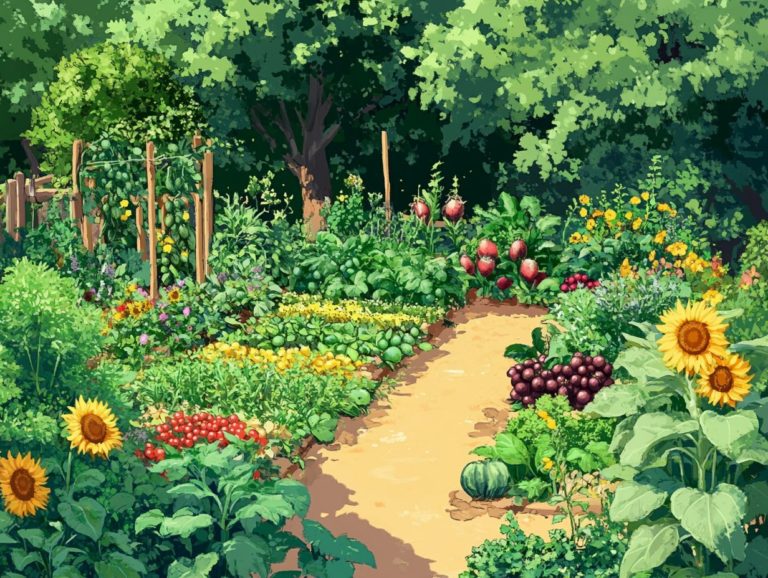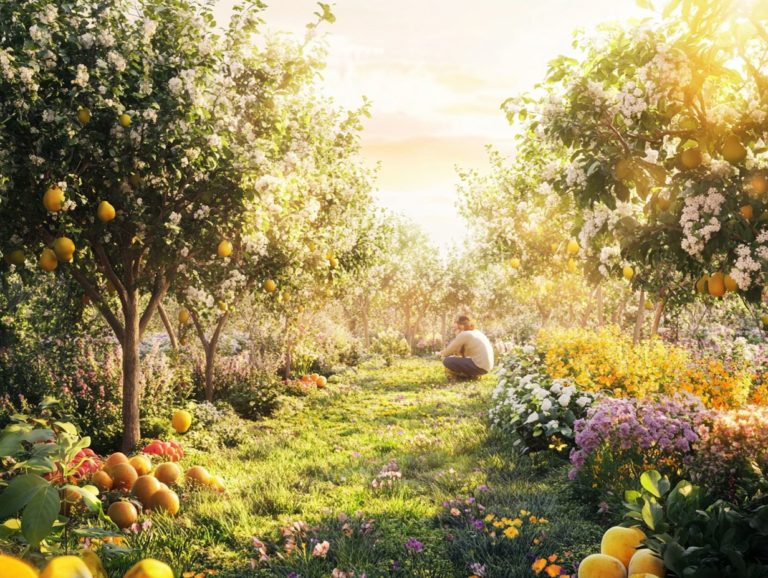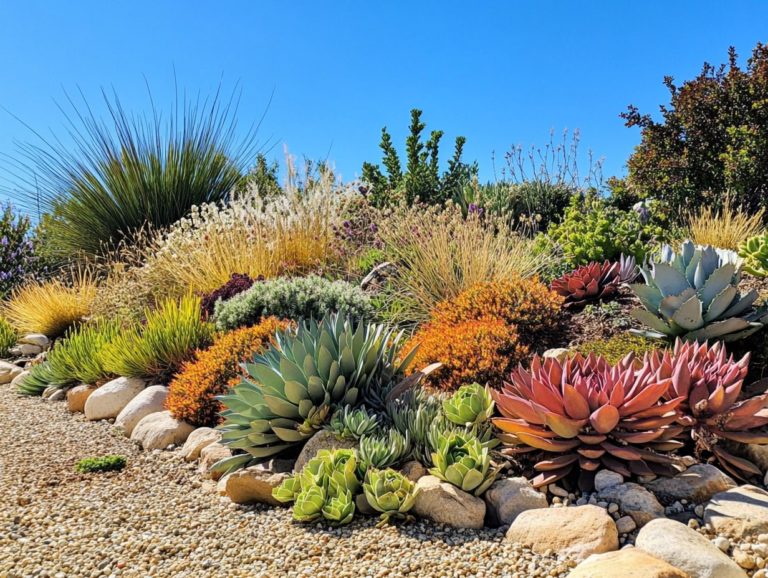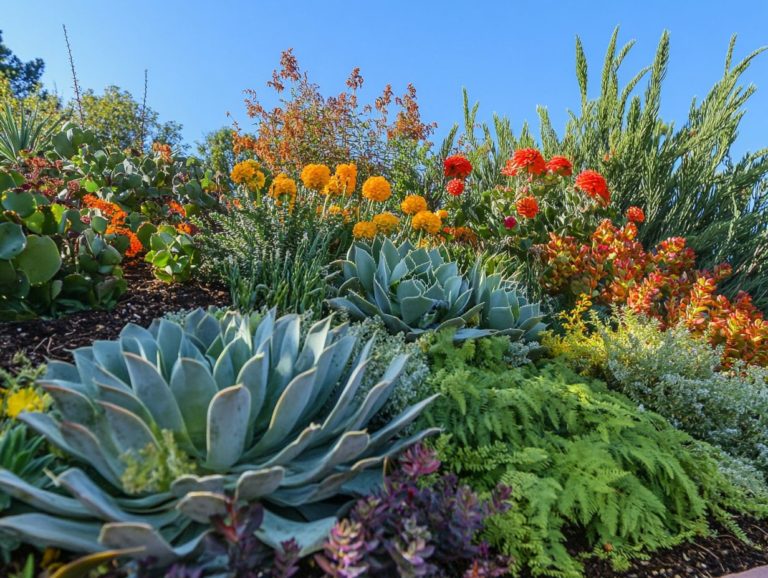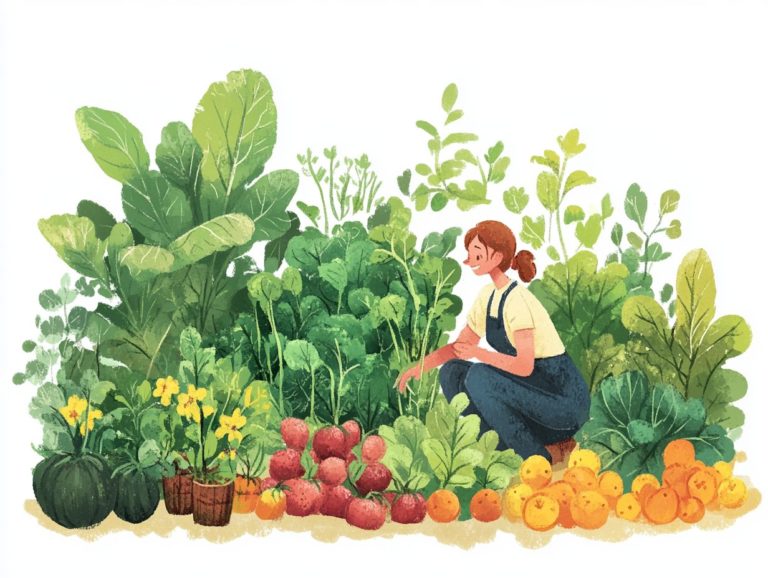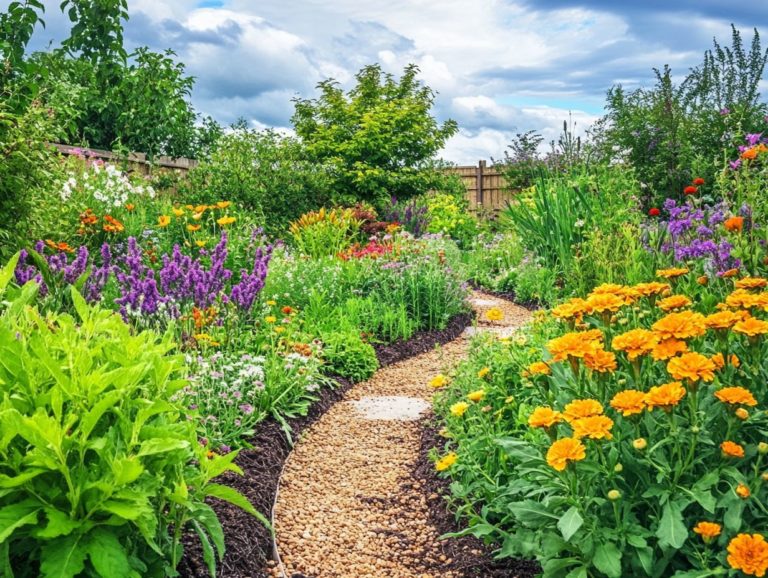“Selecting Plants for a Wildlife-Friendly Garden”
Creating a wildlife-friendly garden is not just a thoughtful choice for the environment; it enhances your outdoor space with vibrant beauty and life.
This guide delves into the significance of attracting wildlife and illustrates how selecting the right plants can truly transform your garden. By opting for native plants and blooms that invite pollinators, you can cultivate a harmonious ecosystem that flourishes.
You ll also discover effective maintenance strategies and tips to accommodate various species, ensuring your garden thrives while providing essential support to local wildlife.
Embrace this green journey and watch your garden flourish!
Contents
- Key Takeaways:
- Choosing Plants for a Wildlife-Friendly Garden
- Creating a Balanced Ecosystem
- Maintaining a Wildlife-Friendly Garden
- Tips for a Successful Wildlife-Friendly Garden
- Frequently Asked Questions
- 1. What is the purpose of selecting plants for a wildlife-friendly garden?
- 2. How can I choose the right plants for a wildlife-friendly garden?
- 3. Are native plants better for a wildlife-friendly garden?
- 4. What are some important factors to consider when selecting plants for a wildlife-friendly garden?
- 5. Can I still have a beautiful garden while selecting plants for wildlife?
- 6. How can I maintain a balance between my garden’s aesthetics and providing for wildlife?
Key Takeaways:

- Attracting wildlife to your garden is important for a balanced ecosystem and provides numerous benefits.
- Select native plants and those that attract pollinators to create a diverse and thriving garden.
- Proper maintenance, natural pest control methods, and creating diverse habitats are crucial for a wildlife-friendly garden.
Why It’s Important to Attract Wildlife
Attracting wildlife to your garden is not just a delightful endeavor; it’s a crucial step in promoting biodiversity, which is the variety of living things in an area, and establishing a vibrant ecosystem. By using natural gardening methods, you can create welcoming homes for a range of species, including vital pollinators and beneficial insects.
These interactions enhance plant growth and soil health while providing essential food and shelter for wildlife. Your wildlife-friendly garden becomes a sanctuary for diverse bird species, insects, and other valuable creatures, contributing to a sustainable future while offering you engaging sensory experiences.
A rich tapestry of wildlife in your garden naturally assists with pest control, minimizing the need for harmful chemicals. Birds, bats, and predatory insects play a vital role in regulating pest populations, leading to healthier plants and reducing crop loss.
Pollinators like bees and butterflies add to the garden’s aesthetic while being essential for the reproduction of many flowering plants. By nurturing a diverse ecosystem, you create beauty and abundance while helping maintain the delicate balance necessary for a thriving environment, reinforcing the vital interconnectedness of all living organisms.
Choosing Plants for a Wildlife-Friendly Garden
Choosing the right plants is essential for crafting a wildlife-friendly garden that flourishes with native shrubs and vibrant flowering plants, enticing a variety of bird species and beneficial insects.
By integrating bird-friendly plants that provide nectar and shelter, you cultivate an inviting habitat for wildlife while enhancing the aesthetic appeal of your garden. This dedication to organic gardening methods not only enriches your surroundings but also nurtures local ecosystems, transforming your garden into a sanctuary for diverse life forms.
Native vs. Non-Native Plants
When designing a wildlife-friendly garden, understanding the difference between native and non-native plants is essential. Native shrubs and flowering plants support local biodiversity, creating a vibrant ecosystem that thrives. These plants are perfectly adapted to your local climate and soil, offering vital resources for wildlife, including insects, birds, and other beneficial creatures.
On the flip side, non-native plants are species that aren t originally from the area and may not support local wildlife. By incorporating native shrubs like elderberry, dogwood, or viburnum, you craft inviting habitats that nurture local pollinators and songbirds while keeping your soil healthy through natural processes.
These plants provide food and shelter and help prevent soil erosion, enhance water conservation, and minimize the need for chemical fertilizers or pesticides that often accompany non-native gardening practices. Embracing organic gardening methods alongside these native species fosters a flourishing garden ecosystem that champions diversity, positively impacting both the environment and your garden’s aesthetic appeal.
Plants that Attract Pollinators
Incorporating flowering plants that serve as nectar sources is essential for attracting vital pollinators like bees and butterflies. These insects play a significant role in both the ecosystem and your garden’s overall design. By selecting a diverse array of plants that bloom at various times throughout the seasons, you can craft a vibrant wildlife garden that supports these beneficial insects year-round.
This thoughtful planting enhances the beauty of your garden and contributes to biodiversity and pest control.
To make the most impact, consider using native flowering plants such as coneflowers, milkweed, and black-eyed Susans. These species not only attract pollinators but also require less maintenance and water, making them a practical choice. Planning for a continuous bloom schedule ensures there s always something flowering, providing a steady food source for these crucial allies.
Integrating flowers like asters in the fall and phlox in the spring helps create a garden that thrives and supports the life cycles of various pollinators, enriching both the garden’s ecosystem and its visual allure.
Plants that Provide Food and Shelter
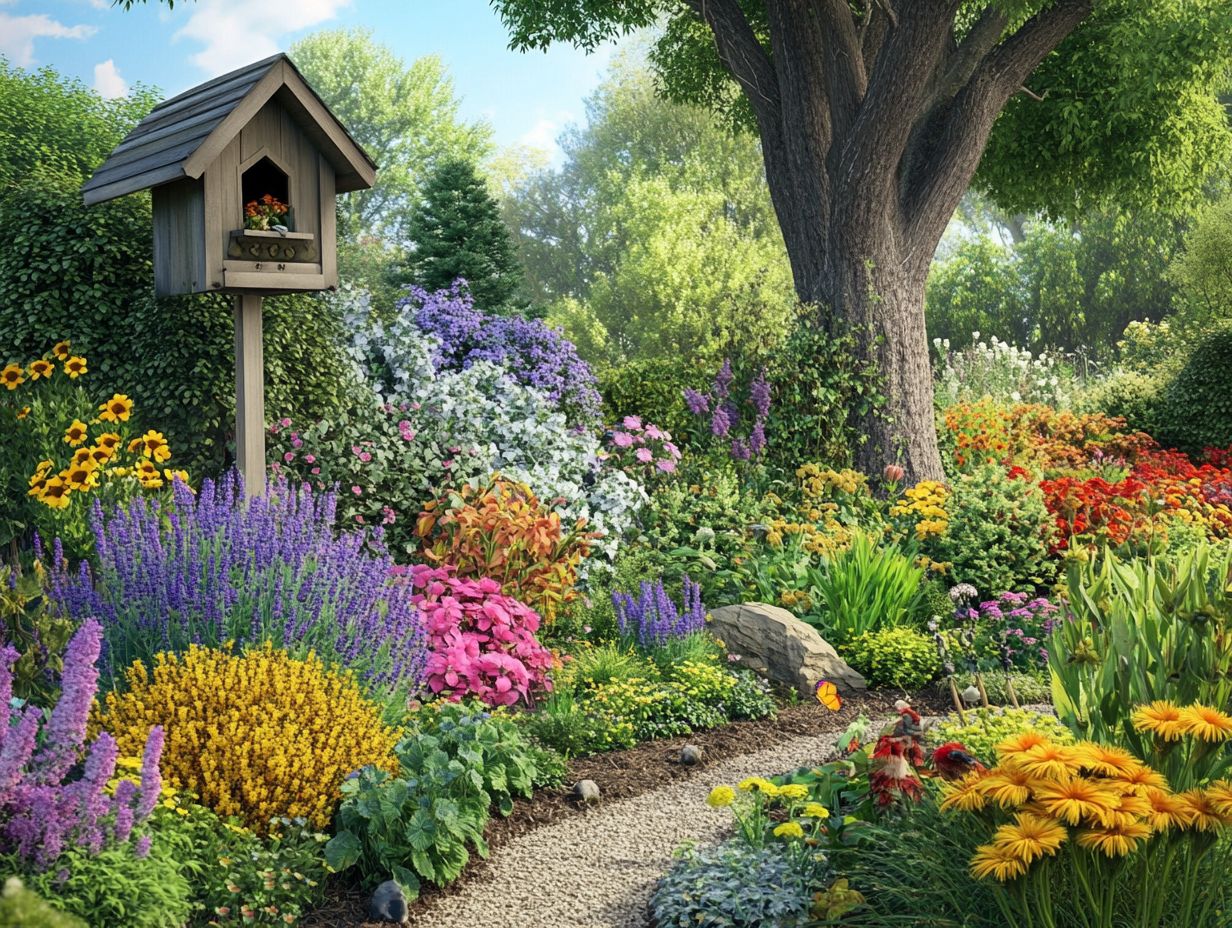
Choosing plants that provide essential food and shelter for wildlife is crucial for cultivating a thriving ecosystem. Select bird-friendly plants and those that offer nesting materials and water sources to invite a diverse array of wildlife to flourish in your garden. With consistent seasonal care, these plants can continually supply vital resources, such as seeds and berries, throughout the year.
Know the needs of different species to transform your garden into a wildlife haven. For instance, native flowering perennials like echinacea and black-eyed Susans enhance the landscape’s beauty while attracting critical pollinators. Meanwhile, shrubs such as blueberry bushes and serviceberries produce fruits that delight birds and small mammals. Regular mulching and pruning will further bolster their health.
Incorporating materials like native grasses and dense shrubs can create safe nesting sites for birds, encouraging them to make your garden their home. Committing to organic gardening practices like using compost and minimizing pesticides ensures a sanctuary for numerous beneficial insects that are vital to this vibrant ecosystem.
Creating a Balanced Ecosystem
Establishing a balanced ecosystem in your wildlife garden demands a thoughtful approach to companion planting and the integration of natural pest control methods. Both are essential for enhancing biodiversity.
By strategically pairing plants, you can cultivate a harmonious environment where beneficial wildlife flourishes. This aids in pest control and promotes soil health.
This eco-friendly gardening practice nurtures a diverse array of species and elevates the overall resilience and productivity of your garden.
Companion Planting
Companion planting is an invaluable technique that allows you to position different plants together, enhancing growth, deterring pests, and attracting beneficial wildlife. It s a cornerstone of organic gardening. By understanding the relationships between various plants, you can cultivate a more resilient ecosystem that naturally regulates pests while providing food and shelter for diverse species.
This method promotes healthy growth and reduces the need for chemical pesticides, benefiting both your garden and the environment.
For instance, planting marigolds alongside tomatoes effectively repels nematodes and other harmful insects, enhancing the overall health of your tomato plants. Similarly, pairing basil with peppers elevates the flavor of the peppers while aiding in pest deterrence. Incorporating legumes like beans into your garden can significantly improve soil nitrogen levels, benefiting the surrounding plants.
This synergistic approach supports biodiversity and fosters a thriving organic gardening environment where plants coexist harmoniously, contributing to a sustainable and productive garden.
Using Natural Pest Control Methods
Natural pest control methods are key to a healthy wildlife garden. These methods use beneficial wildlife to manage pests sustainably.
By attracting predatory insects and birds, you can significantly reduce pest issues without harmful chemicals. Techniques like composting enhance soil health and promote plant vitality.
Integrating native plants and native shrubs provides nectar and shelter. This creates a haven for pollinators and draws in insect-eating birds that help control pests.
Companion planting boosts your efforts; for example, marigolds can deter nematodes while attracting ladybugs. Encouraging ground beetles and lacewings keeps aphid populations in check.
The combination of these natural pest control methods contributes to ecosystem balance. They ensure improved plant health and vibrant flowering, showcasing nature’s defense mechanisms.
Maintaining a Wildlife-Friendly Garden
Maintaining a wildlife-friendly garden requires careful watering and fertilization techniques. Consistent maintenance and seasonal care create optimal conditions for diverse flora and fauna.
Understanding your plants and the wildlife they attract helps you create an inviting environment. This approach boosts garden health and supports sustainability through rainwater harvesting.
Proper Watering and Fertilization Techniques
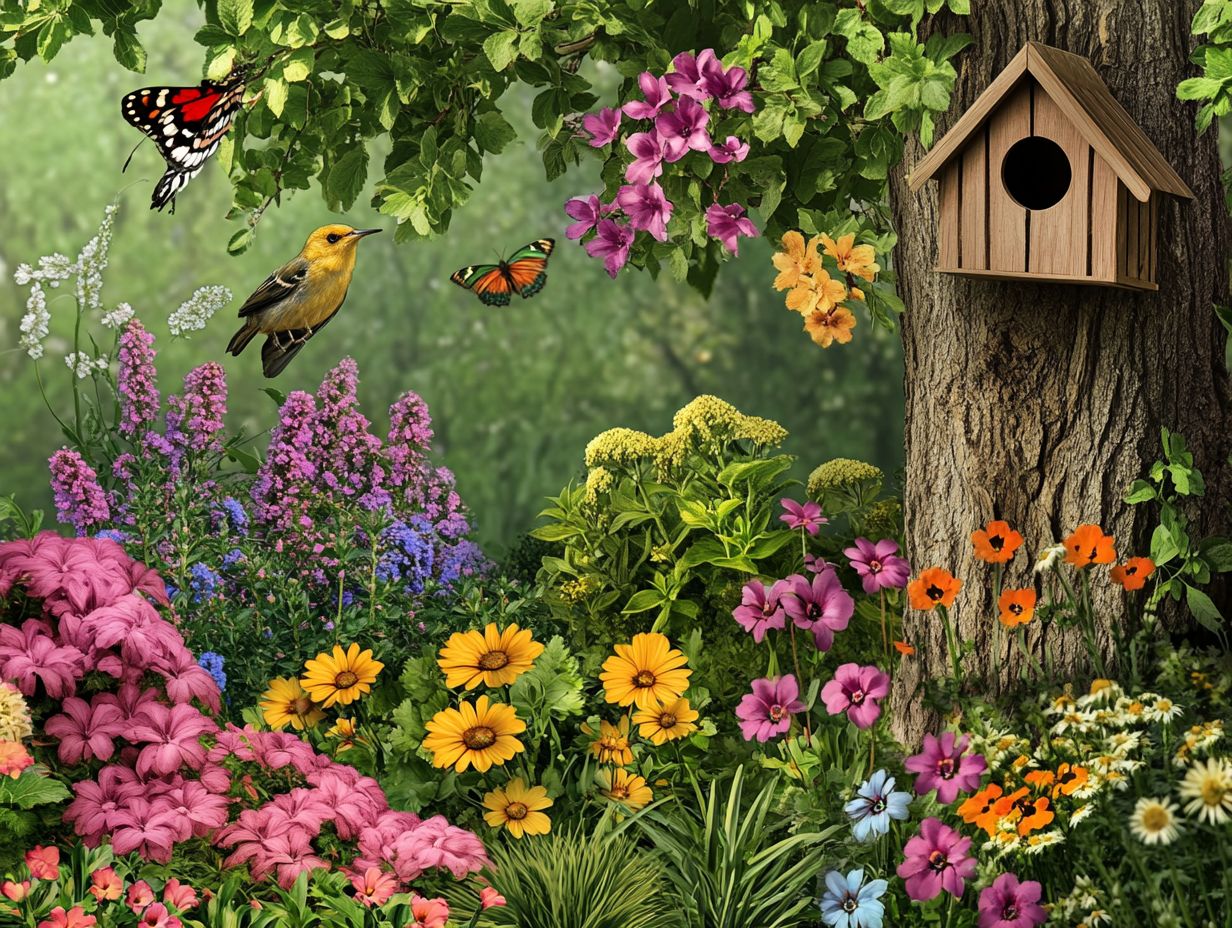
Proper watering and fertilization techniques are essential for a wildlife-friendly garden. They ensure your plants receive necessary nutrients and hydration.
Adjusting these methods throughout the seasons optimizes plant health and supports beneficial wildlife.
Deep irrigation encourages roots to grow deeper, making plants resilient during dry spells. Using rain barrels captures natural rainfall, providing eco-friendly water.
Employing organic fertilizers like compost enriches soil with vital nutrients, fostering robust growth. These methods attract essential pollinators like bees and butterflies.
By implementing these techniques, you’ll create a thriving habitat for wildlife and enjoy a flourishing garden.
Regular Maintenance and Monitoring
Regular maintenance and monitoring are vital for a wildlife-friendly garden. They help every plant and creature thrive while promoting biodiversity.
Keep a close watch on plant health and adjust your care techniques as needed. Tackling any issues early creates a sustainable ecosystem that invites wildlife.
This disciplined approach enhances your garden’s beauty and attracts various species, including popular bird species.
Engaging in key maintenance tasks, like diligent pruning, helps shape your plants for optimal growth. Weeding prevents competition for precious resources.
Watch for wildlife interactions, especially with butterflies and other pollinators; they offer insights into your ecosystem s health and garden design.
Seasonal adjustments are crucial. For instance, prepare habitats, like meadows and plots with hawthorn, before winter to attract migratory species.
By embracing these practices, you contribute to a thriving environment that nurtures both flora and fauna. Transform your garden into a true sanctuary for life!
Tips for a Successful Wildlife-Friendly Garden
Creating a successful wildlife-friendly garden requires a thoughtful strategy. You need to integrate various habitats to meet the needs of different species.
Design your garden with diverse landscapes think meadows with native plants, water features, and shrub areas rich in bird-friendly plants. This creates a welcoming space for beneficial wildlife.
Embrace seasonal care and organic gardening practices. These actions enhance your garden’s vibrancy and support local ecosystems.
Creating a Variety of Habitats
Creating different habitats in your wildlife-friendly garden is key for supporting diverse species. Ensure that plants, water sources (like rain barrels and small ponds), and nesting materials are readily available.
Incorporate elements like ponds, hedgerows, and sheltered areas. These features provide safe havens for birds, insects, and other wildlife, enriching your garden s ecosystem.
For instance, adding a small pond offers water and creates a breeding ground for amphibians, essential for pest control. Hedgerows filled with native plants provide shelter and food for pollinators while serving as natural windbreaks.
Creating sheltered nooks with logs or rocks attracts beneficial insects and small mammals. They play an essential role in natural pest management.
These habitat features enhance biodiversity and bolster your organic gardening efforts. They foster a thriving ecosystem that benefits all inhabitants.
Considering the Needs of Different Species
Considering the needs of different species is essential when cultivating a wildlife-friendly garden, as each creature has its own unique requirements for food, shelter, and water. By understanding these needs, you can create an inviting space that buzzes with life and supports biodiversity!
For example, butterflies flourish on nectar-rich flowers, so planting a variety of blooms that flower at different times ensures a continuous food supply. Birds favor native trees and shrubs, which provide essential shelter and nesting sites, along with natural food sources like berries and seeds.
Using organic gardening practices helps your garden s soil health. Steering clear of pesticides and embracing compost promotes a balanced ecosystem. By creating small areas that provide specific conditions for different wildlife complete with water sources from rainwater harvesting and brush piles you can cater to the specific habitat preferences of various species. This ultimately invites a vibrant community of wildlife into your green oasis, enriching your biodiversity support.
Frequently Asked Questions
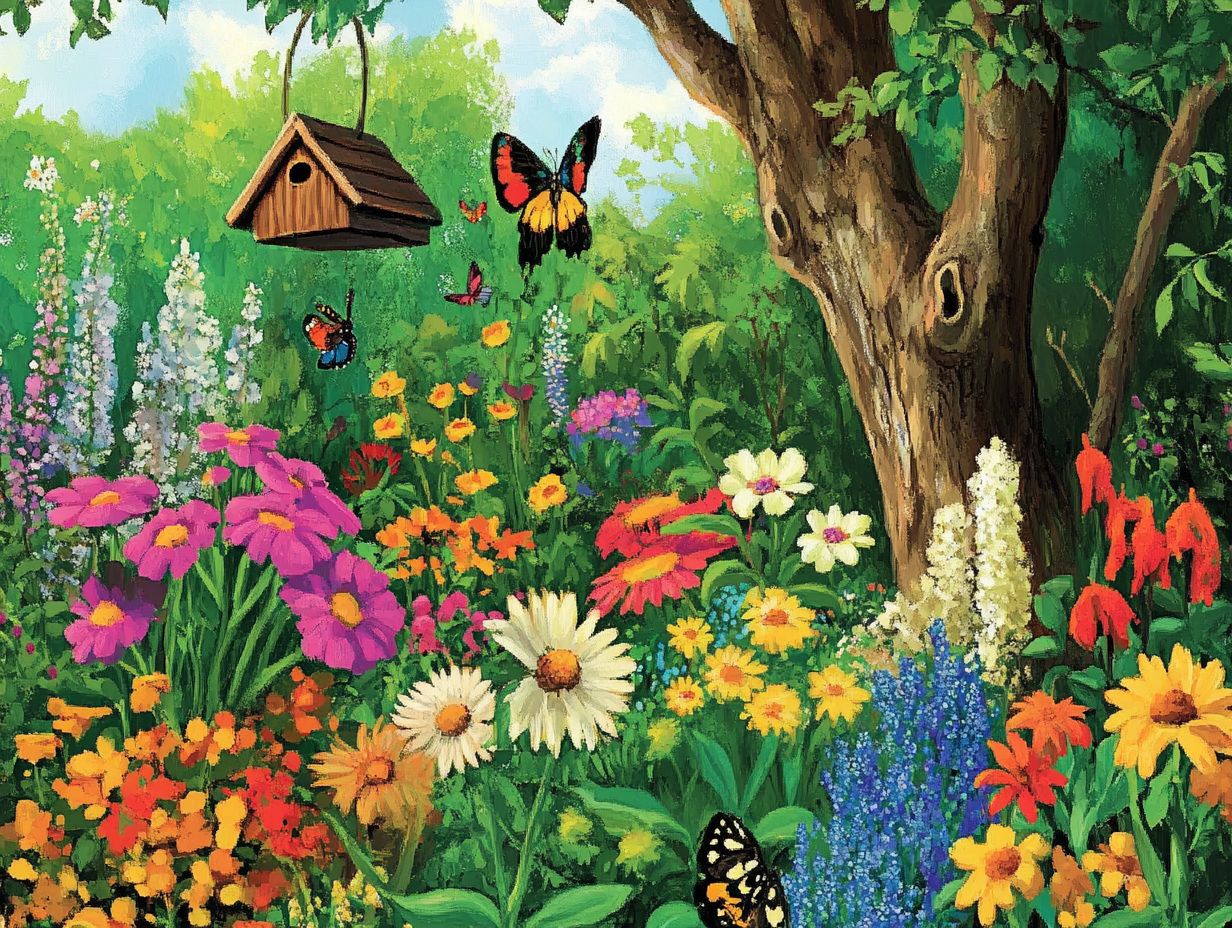
1. What is the purpose of selecting plants for a wildlife-friendly garden?
Selecting the right plants helps create a home for local wildlife and supports their survival and diversity.
2. How can I choose the right plants for a wildlife-friendly garden?
To choose the right plants for a wildlife-friendly garden, consider the needs and preferences of the local wildlife, such as food sources, shelter, and nesting materials.
3. Are native plants better for a wildlife-friendly garden?
Yes, native plants are typically better because they are adapted to the local climate and can provide a more suitable habitat for native wildlife.
4. What are some important factors to consider when selecting plants for a wildlife-friendly garden?
Important factors include the plant’s ability to attract pollinators, provide food and shelter for wildlife, and its compatibility with the local climate and soil conditions.
5. Can I still have a beautiful garden while selecting plants for wildlife?
Absolutely! You can still have a beautiful garden while selecting plants for wildlife. Many native plants are both aesthetically pleasing and beneficial for local wildlife.
6. How can I maintain a balance between my garden’s aesthetics and providing for wildlife?
Maintaining a balance can be achieved by incorporating a variety of plants that offer both visual appeal and serve as a food source or shelter for wildlife. Regular maintenance and proper placement of plants can also help keep your wildlife-friendly garden beautiful.
Start your wildlife-friendly garden today and watch nature thrive!

